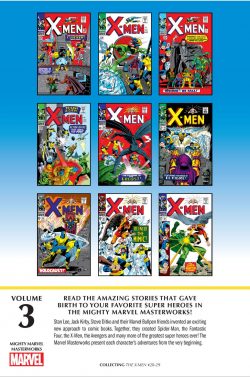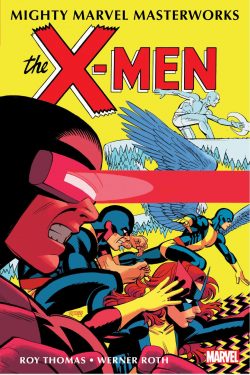

By Roy Thomas, Werner Roth, Dick Ayers, John Tartaglione, Art Simek, Joe Rosen & various (MARVEL)
ISBN: ?978-1-3029-4901-3 (TPB/Digital edition)
Win’s Christmas Gift Recommendation: Celebrate in X-quisite Classical Style… 9/10
These stories are timeless and have been gathered many times so here’s my now-standard advisory on format.
The Mighty Marvel Masterworks line is designed with economy in mind. Classic tales of Marvel – such as the birthday boys and girl on show today – have been an archival book staple since the 1990s, but always in lavish, expensive hardback collectors’ editions. The new tomes are far cheaper, on lower quality paper and smaller, about the size of a paperback book.
Your eyesight might be failing and your hands too big and shaky, but at 152 x 227mm, they’re perfect for kids. If you opt for the digital editions, that’s no issue at all…
Way back in 1963 things really took off for the budding Marvel Comics Group as Stan Lee & Jack Kirby expanded their meagre line of action titles: putting a bunch of relatively new super-heroes (including hot-off-the-presses Iron Man) together as The Avengers; launching a decidedly different war comic in Sgt. Fury and his Howling Commandos and creating a group of alienated heroic teenagers united to fight a rather specific, previously unperceived threat to humanity. Those halcyon days are revisited in this splendid trade paperback/eBook compilation, gathering from May 1966 to February 1967, the contents of X-Men #20-29.
Way back in the summer of 1963, the premiere issue had introduced Cyclops/Scott Summers, Iceman/Bobby Drake, Angel/Warren Worthington III and The Beast/Henry “Hank” McCoy: extremely special students of Professor Charles Xavier. This brilliant, driven, charismatic and wheelchair-bound telepath was dedicated to brokering peace and integration between the masses of humanity and the emergent off-shoot race: human mutants called Homo Superior. The story saw the students welcome newest classmate Jean Grey, who would be codenamed Marvel Girl. She possessed the ability to move objects with her mind.
No sooner has the Professor explained their mission than an actual Evil Mutant – Magneto – singlehandedly took over American missile base Cape Citadel. A seemingly unbeatable threat, the master of magnetism was nonetheless driven off in under 15 minutes by the young heroes on their first combat mission…
These days, young heroes are ten-a-penny, but it should be noted that these kids were among Marvel’s first juvenile super-doers (unless you count Spider-Man or Human Torch Johnny Storm) since the Golden Age, so it’s perhaps unsurprising that in early tales the youngsters regularly benefitted from a little adult supervision, such as is the case in the landmark tale that opens this book…
With Werner Roth & Dick Ayers making the pictures, in X-Men #20, the writing reins were turned over to Roy Thomas, who promptly jumped in guns blazing with ‘I, Lucifer…’: an alien invasion yarn starring Xavier’s arch-nemesis as well as old adversaries Unus the Untouchable and the Blob. Most importantly, it revealed in passing how Professor X lost the use of his legs.
With canny concluding chapter ‘From Whence Comes Dominus?’, Thomas & Roth completely made the series their own: blending juvenile high spirits, classy superhero action and torrid soap opera with beautiful drawing and stirring adventure.
At this time Marvel Comics had a vast and growing following among older teens and college kids, and the youthful Thomas spoke and wrote as they did (or maybe a little better?). Coupled with his easy delight in large casts, this would increasingly make X-Men a most welcoming read for any educated adolescent – like you or me…
As suggested already, X-Men was never one of young Marvel’s top titles, but it found a devout and dedicated following, with the frantic, freakish energy of Jack Kirby’s heroic dynamism comfortably transiting into the slick, sleek attractiveness of Roth as the fierce tension of hunted, haunted juvenile outsider settled into a pastiche of college and school scenarios familiar to the students who were the series’ primary audience.
The action continues with a crafty 2-parter resurrecting veteran Avengers villain Count Nefaria who employs illusion-casting technology and a band of other heroes’ second-string foes (The Unicorn, Porcupine, Plantman, Scarecrow and Eel, if you’re wondering) to hold Washington DC hostage and frame the X-Men for the entire scheme.
‘Divided… We Fall!’ and ‘To Save a City!’ form a fast-paced, old-fashioned Goodies vs. Baddies battle with a decided sting in the tail. Moreover, the tale concludes with Marvel Girl yanked off the team when her parents insist she furthers her education by leaving the Xavier School to attend New York’s Metro University…
Illustrated by Roth & Ayers she is off the team and packed off to college but here visits her old chums to regale them with tales of life outside. Her departure segues neatly into a beloved plot standard – Evil Scientist Grows Giant Bugs – when she enrols and meets an embittered recently-fired professor, leading her erstwhile comrades to confront ‘The Plague of… the Locust!’
Perhaps X-Men #24 isn’t the most memorable tale in the canon but it still reads well and has the added drama of Jean Grey’s departure crystallizing the romantic rivalry for her affections between Cyclops and Angel: providing another deft sop to readers as it enabled many future epics to include Campus life in the action-packed, fun-filled mix…
Somehow Jean still managed to turn up in every issue even as ‘The Power and the Pendant’ (#25, October 1966) finds the boys tracking new menace El Tigre. This South American hunter is visiting New York to steal the second half of a Mayan amulet which willgrant him god-like powers…
Having soundly thrashed the male X-Men, newly-ascended and reborn as Kukulkan, the malign meta returns to Amazonian San Rico to recreate a fallen pre-Columbian empire with the heroes in hot pursuit. The result is a cataclysmic showdown in ‘Holocaust!’ which leaves Angel fighting for his life and deputy leader Cyclops crushed by guilt…
Issue #27 see the return of some old foes in ‘Re-enter: The Mimic!’ as the mesmerising Puppet Master pits power-duplicating Calvin Rankin against a team riven by dissention and ill-feeling, before ‘The Wail of the Banshee!’ sees Rankin join the X-Men in a tale introducing the sonic-powered mutant (eventually to become a valued team-mate and team-leader) as a deadly threat.
This was the opening salvo of an ambitious extended epic featuring a global coalition of sinister, mutant-abductors… Factor Three.
This turbulent tome terminates with John Tartaglione replacing Ayers as regular inker beginning with bright and breezy thriller ‘When Titans Clash!’, wherein the power-duplicating Super-Adaptoid almost turns the entire team into super-slaves before ending the Mimic’s career…
Supplemented by original art – an unused Roth cover for X-Men #25 – these charming idiosyncratic tales are a million miles removed from the angst-ridden, breast-beating, cripplingly convoluted X-brand of today’s Marvel, and in many ways are all the better for it. Superbly rendered, highly readable adventures are never unwelcome or out of favour and it should be remembered that everything here informs so very much of the mutant monolith. These are stories for dedicated fans and the rawest converts. Everyone should have this book.
© 2023 MARVEL
